The most extensive stage of Peruvian history is that which precedes the Spanish conquest at the end of the 15th Century. The oldest pieces of evidence of human beings in Peru allow us to suppose that man arrived there around one hundred thousand years ago, coming from other continents towards the end of the last glacial age, in the Pleistocene to be exact. Let’s analyze what were the most ancient civilizations of Peru.
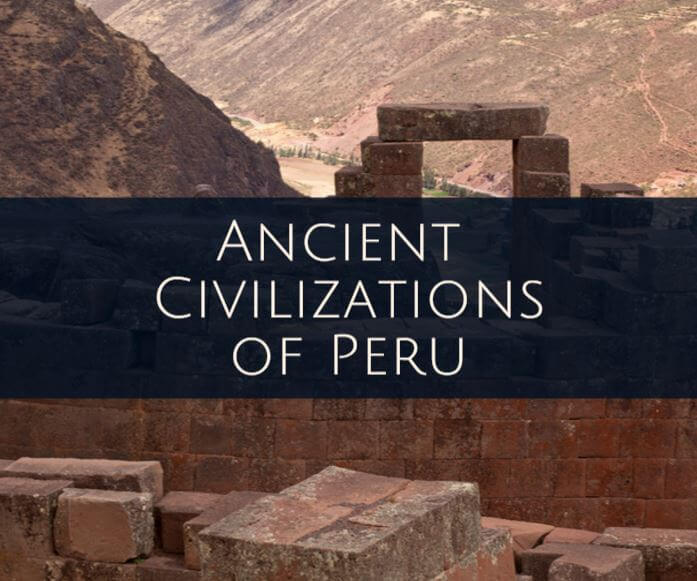
Ancient Civilizations of Peru
Contents
The first Peruvians, organized in bands and clans, were hunters and gatherers. The hunting of South American Camelids in the high Andean zones (especially Guanacos); and the fishing and collection of seafood on the coast of the Pacific Ocean (taking advantage of the biological richness of the Humboldt Current) were their primary economic activities. They also made tools of carved stone.
The progressive discovery of agriculture (Archaic Period) permitted a more and more sedentary economy. The agricultural cycles, dominated by astronomer-priests, endowed these priests with great power. Because of this, it is believed that the first complex organizations were of a theocratic type. The first temples arise in the central and north-central coast, and in the central mountain range. With them, the Andean Civilization begins.
Origins of the Peruvian Culture
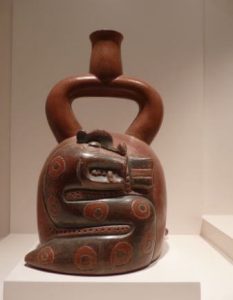
Peruvian culture is a great mix of components from distinct ethnic groups which inhabited and inhabit what is currently the territory of Peru, the most important are the aboriginal and Creole or Spanish block, followed by the Afro-Peruvian and Asiatic blocks and in smaller measure the Italo-Peruvian, all this is encouraged by the three main natural regions, that is to say the coast, the jungle, and the mountains. It is because of this that the Peruvian culture is considered a Mestiza culture and this is amply demonstrated in its gastronomy which is recognized for its variety of dishes, drinks, and desserts, and the dances like the Marinera, the Festejo, the Tondero, the Huayno, the Huaylas, the Wititi, the Diablada, and the Huayruros among others.
Early Regional Cultures
Towards the year 200 B.C. civilization has evolved to more complex political forms. Agriculture becomes extensive, constructing great irrigation systems over the deserts of the north and central coast and ingenious subterranean aqueducts on the south coast. The societies of the Moche, Nazca, Recuay, Cajamarca, Vicus, Lima and Tiahuanaco (with its capital in a great ceremonial center of the same name in northern Bolivia) are the most known and successful of this period. The majority of them seem to have been ruled by sophisticated warrior-elites who supported the production of artistic objects of great quality, which are considered some of the most important works of Pre-Columbian American art (especially the Moche, Nazca, and Recuay pottery; the Nazca textiles, the Moche jewelry, and the Tiahuanacan stone art).

List of the main early Peruvian cultures where the history is seen from start to finish.
- Chavín Culture
- Paracas Culture
- Pucara Culture
- Nazca Culture
- Mochica Culture
- Recuay Culture
- Cajamarca Culture
- Vicús Culture
- Lima Culture
- Tiahuanaco Culture
- Chimu Culture
- Huari Culture
- Chincha Culture
- Chancas Culture
- Chancay Culture
- Lambayeque Culture
- Chachapoya Culture
About the most Ancient Cultures of Peru
Cupisnique Culture (900 B.C. – 200 B.C.)
The Cupisnique culture of the north coast of Peru extends from Virú to Lambayeque. It has to do with a coastal culture contemporaneous to the Chavín culture and which precedes the Moche culture. This culture is located in the region of La Libertad, 600 km to the north of the city of Lima, although it is not known with certainty which was its main center. Various vestiges of this culture exist, which extend along the north coast of the country and reach as far as the region of Piura. The Cupisnique ceramics show anthropomorphic, zoomorphic and phytomorphic figures. In sculpture, their sculpted heads worked in relief represent feline heads. They would constitute a version of the Chavín nailed heads.
Chavín Culture (1000 B.C. – 200 B.C.)
The Chavín culture develops starting from the ceremonial center of Chavín de Huántar, in the mountains of the region of Ancash. Chavín is 300 km to the north of the city of Lima. It is one of the most important and ancient cultures of the Pre-Inca past. This culture is based on agriculture and develops textile making, pottery, metallurgy, and works in stone. It is considered the “Womb of Andean civilization”; it extended from Lambayeque to Palpa (Ica) on the coast and from Cajamarca to Ayacucho in the mountains. In the Chavín Temple sculptures are found nailed to the walls; with the form of human heads, a mix of feline and man. The Chavín Culture achieved a great mastery of stone, recording, and sculpting anthropomorphic and zoomorphic figures. On the other hand, their ceramics are of a dark gray color, with a tendency to equal the color of the stone; (monochrome: only one color), in globular form (round), stirrup-necked with only one mouth and decorations of felines like the jaguar.
Paracas Culture (400 B.C.– 200 A.D.)
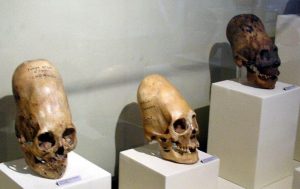
The Paracas culture developed during the period denominated the Early Horizon. It was discovered by the archaeologist Julio C. Tello, who, on finding the site of Cabezas Largas, believed he had discovered the place of origin of the great cultures of the south. Paracas was divided into two periods, “Paracas Cavernas,” and “Paracas Necropolis.” Studies later than those of Tello demonstrated that the development of this culture had been longer and more complex. In the second phase of Paracas, we can find villages, one of them in the area of Cerro Colorado, and the other in Arenas Blancas. Paracas was the antecedent of the Nazca culture, which developed years later in that area. The men of Paracas dedicated themselves to hunting, fishing and fledgling agriculture (Lima beans, cotton, and corn). They are famous for their fine cloaks, funerary bundles, and cranial trepanations. Paracas was a local civilization of solid southern tradition. Its influence extended from Cañete in the North to the valley of Yauca in Arequipa to the South. Its main center could be the site of Peña de Tajahuana, in the Ica Valley, 300 km to the south of the city of Lima.
Vicús Culture (100 B.C. – 400 A.D.)
The Vicús culture or style occupied the zone of Alto Piura, in the north of Peru, 1050 km to the north of the city of Lima and was discovered by clandestine excavators (“grave robbers”), at the end of the decade of the 1950s, in the area of Frías, in the province of Ayabaca. In the following decade, studies done in the area of Cerro Vicús were able to locate the most extensive cemetery of this style. It is calculated that during the years in which it was clandestinely exploited more than two thousand tombs would have been profaned, whose contents, more than 40 thousand specimens would have passed for the most part into collections in foreign countries. Its ceramics are characterized by their solid and rustic appearance, as well as their realistic sculptural tendency. The metal objects in the Vicús style have very particular characteristics, as they utilized techniques for working with gold, whose area of diffusion corresponds to the basin of Alto Piura.
Moche Culture (0 – 600 A.D.)
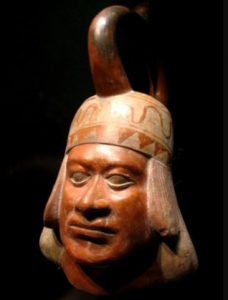
It is the most known and admired culture of ancient Peru, having developed during the period considered the Early Intermediate. Towards the year 200 of our time, the dominion of Moche arose on the north coast, which lasted until the year 600, centering itself around the valleys of Moche and Chicama, where great ceremonial centers are found in addition to vast works of irrigation. Its origins are found in the formative cultures of the region, like those of the Jequetepeque river valley. In textiles, their techniques were varied and in addition to that mentioned before they also utilized twilled fabric, double fabric, and gauze. In other areas, the Mochica ceramics were basically dichromatic (red on cream), unusually of an orange color, and very few in smoky transparent black. The most representative are their Huaco portrait vessel sculpted ceramics, which according to the investigator Anne Marie Hocquenghem are real portraits of individuals or representations of characters with precise functions. On the other hand, regarding metallurgy, the origin of the raw materials used by the Moche is unknown; however, it is estimated that the gold and silver were exploited from alluvial deposits and from the ore bodies of the region. The inhabitants of the coast were expert metallurgists, having developed techniques like metal beating, hammering, and soldering. In addition to laminating and soldering the metal, they discovered how to solder and inlay it.
Cajamarca Culture (200 A.D. – 1300 A.D.)
In 1948, the investigator Henry Reichlin divided the Cajamarca culture into five stages, according to the influence they held, from Chavín to the Incas. The first phase of Cajamarca happened during the Early Intermediate, located in the Chondorko hills, near the Baños del Inca in Cajamarca. It dealt with a type of association of independent states, which maintained economic relationships with neighboring cultures, like Lambayeque and Chimú. The following phases of the Cajamarca culture had influence from the Wari and the Incas. The territory of Cajamarca covered three large areas: the high basin and the valleys of Chancay, Lambayeque, Chayama, and Chotano. The Pre-Inca center of Cajamarca was located in the area occupied today by the provinces of Cutervo, Chota, Santa Cruz, Hualgayoc, San Miguel, Celendín, Contumazá, San Pablo, San Marcos, Cajabamba and Cajamarca, in the region of Cajamarca; and in Huamachuco and Otuzco in the region of La Libertad. Regarding architecture, six distinct types of settlements in Cajamarca have been recognized. The prototype of the settlements of the Cajamarca culture is Cerro Nivel, located in the Pampa de la Culebra, 13 kilometers from the city of Cajamarca. The central part of this site is composed of united groups of enclosed fields, built on terraces. In another area, their ceramics were one of the most significant elements of the material culture of the men of Cajamarca. The changes in their artistic tendencies can be inferred from the changing political situations, which affected the makers just as much as the users. The Cajamarca vessels have decorations of geometric figures, with a rounded base, colored black, red, and white over an orange base, or over the natural background of the clay.
Nazca Culture (0 – 800 A.D.)
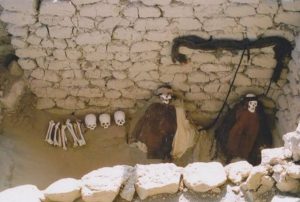
This local culture emerged as a process of continuation of the Paracas tradition. It began around the first years after Christ and continued in an independent form for approximately 800 years, the time when it received the Huari influence; Kawachi was the capital of the Nazca society, located 49 km from the current city of Nazca in the basin of the Rio Grande and 500 km to the south of Lima. The most amazing thing about the Nazca are the lines and figures which were discovered in 1926 by Toribio Mejía Xesspe, a disciple of Julio C. Tello, and later rediscovered by the anthropologist Paúl Kosok in 1939, which are found located in the pampas of San Jose de Socos, between kilometers 419 and 465 of the southern Pan-American highway in an extension of 500 square kilometers; it is speculated that it had to do with an enormous calendar-observatory constructed in a period of 800 years to mark the solstices and the equinoxes. In other areas, their textiles maintain the Paracas style, they kept making embroidered cloaks; the materials employed are cotton and wool. With respect to their ceramics, they were finely developed and very well decorated, characterized mainly by being polychromatic (the use of various colors). They utilized up to 8 colors with a predominance of ocher, Indian Red, yellow ocher, black and dark gray. The Nazca worked primarily with gold. The most common technique was hammered and cut gold utilized to make garments for important characters and priests. Later on, they used copper and the technique of casting.
Tiwanaku Culture (100 A.D. – 1000 A.D.)
The Tiwanaku or Tiahuanaco culture is found in the high Bolivian plane or the Collao mesa, a territory of great altitude, from 3800 to 4000 meters above sea-level. It has to do with a culture which developed in a rugged territory, where the climatic conditions are extremely tough. Agriculture is restricted to the most restricted tubers; however, investigations have demonstrated that the Tiwanaku culture formed a powerful state, as in the center of Tiwanaku, near Lake Titicaca, more than 4 square kilometers of domestic remains have been found, which suggests that there were between 20 and 40 thousand inhabitants. The architectural complex of Tiwanaku is located 20 kilometers to the south of Lake Titicaca. It is an urban center composed of administrative and religious buildings which surround semi-sunk plazas and platforms. At the center of this complex is found the building of Kalasasaya. Other buildings are the Semi-subterranean Pavilion, Keri Cala, Putuni, Laka Kollu; and the pyramids Akapana, Pumapunku and Wila Pukara, which served as residences for the priestly elite. In other matters the Tiwanaku style of ceramic presents symmetric details, it is realistic and has a combination of the colors black, ocher, red, white and gray. The most common type of vessel is the “kero,” decorated on one of the sides with a face of apparently human form, presented in bas-relief.
